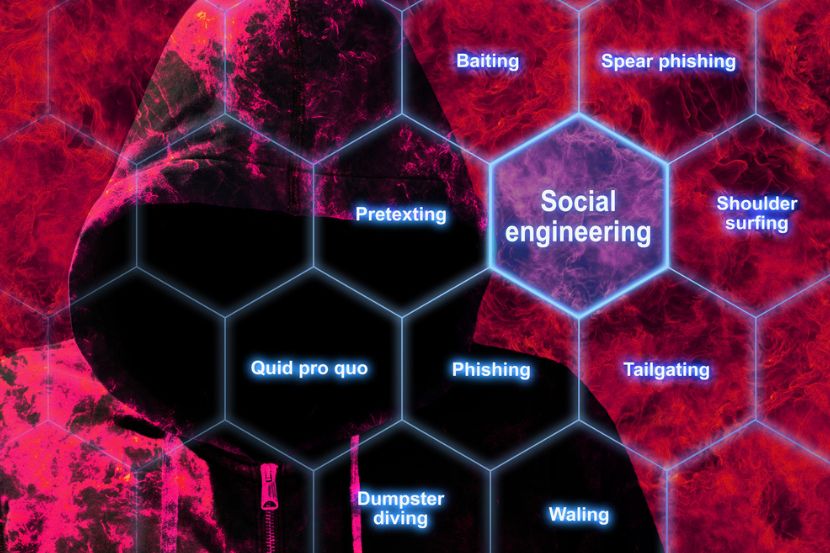Social engineering is an attack vector cyber criminals use to gain access to a network, system, or physical location. It is founded on manipulating or deceiving individuals into divulging confidential information, providing unauthorized access, or performing actions that compromise security.
Unlike traditional hacking, which targets software and systems, social engineering is aimed directly at people, leveraging universal psychological traits and behaviors to achieve its goals.
It's important to recognize that social engineering is not just about technology or cyber security. It's about understanding human nature, our tendencies to trust, to fear, to want to help, and to seek reward.
This article explains everything you need to know about social engineering, including how to recognize it and prevent it from happening in your organization.

What Is Social Engineering?
Social engineering exploits human psychology to manipulate people into sharing confidential information about themselves or their company. Cyber criminals trick these individuals into downloading malware, clicking an infected email attachment, visiting a malicious website, or even sending them money. The result is a serious compromise of both their personal and their company’s security.
Falling victim to social engineering leads to consequences such as data breaches, financial losses, and data corruption that harm everyone in the company.
There are many types of cyber attacks that companies may fall victim to. Learn all about them to prevent harm to your customers, partners, and employees.
How Does Social Engineering Work?
Social engineering targets vulnerabilities in people rather than weaknesses within software and security systems in an organization.
Humans are considered the weakest link in online security, as they are prone to distraction, rash decisions, and carelessness. To gain unauthorized access to information, cyber criminals exploit the following human traits and biases:
- Trust: Social engineers often pose as a trustworthy figure or someone belonging to the target’s group (e.g., colleagues, friends, etc.)
- Authority: The victim is likelier to comply with a request if it seems to come from a figure of authority (e.g., company executives, IT administrators, the police).
- Reciprocity: People feel obliged to return a favor, and cyber criminals will provide a token gift or favor to induce a sense of obligation.
- Fear and urgency: Creating a sense of urgency and a fear of non-action compels people to make hasty decisions.
- Greed: Financial incentives and offers of easy money make people bypass security precautions.
- Curiosity: Social engineers might offer “insider information” or tell a compelling story to stimulate the victim’s curiosity.
- Sympathy: People are more likely to comply with a request if it comes from someone in distress or need.
- Naivety: Refers to people’s tendency to underestimate the likelihood of becoming a victim of social engineering.
- Ignorance or lack of awareness: The lack of knowledge of the tactics social engineers employ makes people susceptible to scams.
Phases of Social Engineering Attacks
Social engineering attacks typically proceed along these steps:
- Research: Cyber criminals research their potential targets to gain more intel about them and execute a social engineering attack without raising suspicion. They usually do this by studying their victims’ social media profiles, company websites, or even surveilling their real-life movements and activities.
- Choosing a technique: Based on the research findings, the attacker selects the method they believe will be most effective in achieving their objectives, such as phishing, whaling, baiting, or another form of cyber attack.
- Attack: The cyber criminal initiates the attack by appealing to one or more of the human tendencies mentioned above. This increases the likelihood the victim will unknowingly compromise data integrity instead of questioning the request or the person behind it.
- Action: After the victim has shared a password, downloaded malware, or transferred funds, the attacker proceeds to commit fraud, install spyware, steal data, or perform another type of harm to the company's systems.
10 Types of Social Engineering: Attack Techniques Explained

There are many types of social engineering attacks criminals perform on unsuspecting individuals. Recognizing them is key to the prevention and protection of sensitive data.
Here are the most common types of social engineering attacks.
1. Phishing
Phishing is a fraudulent attempt to steal sensitive information by posing as a trustworthy entity online. There are several types of phishing, including:
- Spear phishing: Targeting a group of individuals or companies.
- Whaling: Targeting a specific high-level person within a company.
- Voice phishing: Phishing via telephone.
- Smishing: Phishing through text messages.
- Email phishing: Phishing via email.
- Angler phishing: Phishing through social media.
2. Pretexting
Pretexting is an attempt to obtain confidential information from the victim by creating a fictitious scenario (the pretext) to persuade the victim to reveal information or perform an action. It rests on the attacker's ability to establish trust and authority by posing as a coworker, superior, or member of the IT team.
An example of pretexting is when an employee receives a call from someone claiming to be from technical support, stating they are performing a routine security check that requires the victim to “verify” their identity. They further manipulate the victim to reveal sensitive information by creating a sense of urgency and using technical jargon to make the claim sound legitimate.
3. Baiting
Baiting exploits human greed and curiosity to entice the victim. It involves tricking the target into downloading malicious software.
In a common baiting scenario, the attacker leaves a USB drive with an enticing label, such as “Confidential” or “2024 Salaries”, where the target is likely to find it. Driven by curiosity, the victim plugs the USB drive into a computer, unintentionally installing malware or providing an entry point into the network.
4. Tailgating (Piggybacking)
Tailgating is a physical security breach that involves an attacker gaining unauthorized access to a restricted area by following (or tailgating) authorized personnel. The perpetrator will closely follow a member of staff into the facility, posing as someone who should be there, and perhaps carrying a heavy box. By exploiting human carelessness and social norms (such as holding the door for someone), they may gain access to a server room or other restricted area.
5. Scareware
Scareware is a type of social engineering attack where the victims are repeatedly sent false alarms and fake threats about their data being compromised. The attacker creates a sense of urgency and fear in the victim so they download malicious software presented as a solution to some non-existent problem. Scareware attackers usually pose as figures of authority, such as legitimate antivirus software providers or government agencies (e.g., the FBI).
6. Honey Trapping
Honey trapping is a form of social engineering where the attacker gains the victim’s trust by entering a romantic relationship or friendship with them. They then get them to reveal sensitive information such as passwords or confidential company information.
7. DNS Spoofing
Domain Name System (DNS) spoofing is creating a website or sending an email that closely resembles a legitimate, trusted site or email domain. The attacker tricks the victim into thinking they are interacting with an authentic site or email by slightly altering the domain name or email. Examples of these alterations include using similar-looking characters (the number “0” instead of the letter “O”), or using a domain name that is a common misspelling of a legitimate site (e.g., “goggle.com” instead of “google.com”).
Domain spoofing is often used in phishing attacks.
A healthy DNS infrastructure is essential for keeping your business-critical services running. Learn how to protect it by employing the best DNS security practices.
8. Water-Holing
In water-holing, the hacker exploits a vulnerability on a website their targets are known to visit frequently. Once one member of the targeted group visits the site, they become infected with malware. The name comes from the natural world, where predators stalk their prey near watering holes.
9. Diversion Theft
Diversion theft is a tactic where the attacker diverts the target's attention to steal data, money, or physical assets.. The diversion can be physical, such as diverting an expected delivery. An example of a digital diversion would be a DDoS attack that acts as a smokescreen for something else entirely. In this scenario, hackers perform a data breach and steal confidential information while the IT security team is distracted by an influx of internet traffic.
10. Quid Pro Quo
A “quid pro quo” social engineering attack involves cyber criminals offering enticing rewards to their victims in exchange for them sharing sensitive information or performing an action. Attackers might offer technical assistance, a gift, or a financial incentive to obtain login information, credential verification, or other sensitive data such as social security and bank account numbers.
Read about the 15 famous social engineering attacks to understand how to better protect yourself and your organization.
How to Prevent Social Engineering Attacks

Preventing social engineering attacks includes both the human factor and advanced technological solutions that protect your systems and data.
Here is a brief list of methods you can implement to prevent social engineering attacks:
- Frequent security awareness training.
- Regular software updates.
- Verification of all requests for information and money.
- Multi-factor authentication (MFA).
- Zero-trust security model.
- Limiting personal information sharing online.
- Securing physical access to office spaces.
- Enterprise password management.
- Regular data backups.
- Email security best practices.
- Endpoint security.
- Continuous monitoring.
- Limiting access to company information.
- Employing a healthy dose of skepticism and acting accordingly (reporting suspicious behavior and online interactions, etc.).
How to Recognize a Social Engineering Attack
When engaging in online interaction, it is crucial to always retain awareness. If something feels off, it’s always better to trust your gut and verify the request rather than risk making a mistake that compromises data and systems.
Here are some of the tell-tale signs that someone is trying to perform a social engineering attack:
- Unsolicited contacts: Someone is contacting you out of the blue to request sensitive information or a money transfer.
- Suspicious email addresses: The contact information does not match or contains grammar errors.
- Unusual information requests: The person contacting you asks you to share confidential information, such as passwords or PINs, online.
- Suspicious attachments or links: Social engineering hackers send compromised attachments or links for you to click and compromise your data.
- Deceptive URLs: Hover over suspicious URLs with your mouse without clicking to check their validity. If you are still not sure where they will lead, it is best to avoid clicking altogether.
- Generic salutations: If the sender is referring to you as “customer” or “Sir/Madam” instead of your actual name, they are probably attempting phishing.
- Unknown senders: If someone is attempting to contact you, but you don’t recognize them or their information, be on high alert.
- Information does not match: If someone is inconsistent in their story, they are probably attempting to deceive you.
- Unexpected money requests: Be wary of unexpected money transfer requests or requests to send the money to a new bank account without verifying it first.
- Flattery: Be cautious when someone is trying to flatter you or charm you unexpectedly, especially when it is followed by a request to share information or transfer money.
Navigating the Human Firewall
Social engineering capitalizes on human emotions to turn them against us and manipulate us to share confidential information with cyber attackers. It is proven that the human factor poses a greater risk to online security than any machine or technology.
Therefore, it is essential to exercise caution and common sense in all social interactions that may seem suspicious, unexpected, or exploitative in any manner. Regular security awareness training helps individuals recognize manipulation tactics and respond appropriately before damage occurs.



